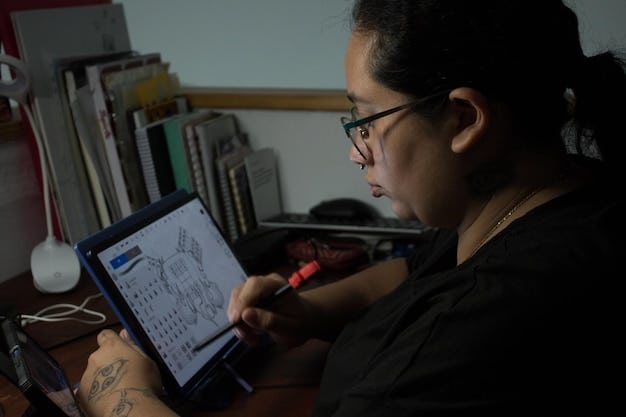The Future of Film: Trends Predicting 2025 and Beyond

The Future of Film: Predicting the Trends of 2025 and Beyond involves immersive experiences, streaming dominance, AI-driven creativity, and shifts towards diverse, inclusive storytelling which are reimagining cinematic landscapes.
What will we be watching in 2025 and beyond? The future of film is rapidly evolving, and understanding these shifts is crucial for filmmakers, enthusiasts, and industry professionals alike. This article explores the transformative trends shaping the landscape of cinema, from advancements in technology to changing audience preferences. Get ready to delve into the future of film: predicting the trends of 2025 and beyond.
The Rise of Immersive Experiences
One of the most significant trends in the future of film is the move towards immersive experiences. As technology advances, audiences increasingly seek to be transported into the worlds they are watching. This trend encompasses everything from virtual reality (VR) to enhanced cinematic environments.
Virtual Reality Cinema
VR cinema aims to fully immerse viewers in the film’s environment. By using VR headsets, viewers can look around, interact with the scene, and feel like they are truly part of the story.
Enhanced Cinematic Environments
Beyond VR, theaters are enhancing the viewing experience with features like motion seats, scent technology, and 4D effects. These additions aim to provide a multi-sensory experience that elevates the emotional impact of the film.
- VR headsets offering 360-degree views.
- Motion seats synchronized with the film’s action.
- Scent technology releasing relevant aromas.
- 4D effects such as wind, rain, and tactile sensations.

Immersive experiences are not just about technology; they are about creating deeper emotional connections with the story. As these technologies become more accessible, they will fundamentally change how films are consumed and appreciated.
Streaming Services Dominate the Landscape
Streaming services have reshaped the film industry, becoming a primary platform for both production and distribution. This shift has impacted everything from release strategies to the types of content being produced.
Original Content and Exclusive Releases
Streaming platforms are investing heavily in original content, offering exclusive films and series that cannot be seen anywhere else. This strategy attracts subscribers and establishes the platform as a source of high-quality entertainment.
The Decline of Traditional Theaters?
With more films premiering directly on streaming services, traditional movie theaters face increasing competition. The key to survival may lie in offering unique experiences that cannot be replicated at home, such as IMAX or luxury seating.
- Netflix continues to expand its library of original films.
- Amazon Prime Video invests in blockbuster-level productions.
- Disney+ leverages its iconic franchises for exclusive content.
- Hulu focuses on diverse and niche programming.
The dominance of streaming services presents both challenges and opportunities for filmmakers. While it opens doors for wider distribution, it also changes the financial models and audience expectations.
AI-Driven Creativity in Filmmaking
Artificial intelligence is beginning to play a role in various aspects of filmmaking, from scriptwriting to visual effects. AI tools can assist in creating more compelling stories and enhancing the overall production process.
AI in Scriptwriting
AI algorithms can analyze vast amounts of data to identify successful story patterns and character archetypes. This information can be used to generate script ideas or to refine existing scripts, potentially leading to more engaging narratives.
AI for Visual Effects and Animation
AI is revolutionizing visual effects and animation, making it easier to create realistic environments and characters. AI tools can automate tasks such as rotoscoping and compositing, reducing production time and costs.

The use of AI in filmmaking raises questions about creativity and authorship. While AI can augment human capabilities, the artistic vision remains essential for producing meaningful and impactful films.
The Push for Diversity and Inclusion
Audiences are increasingly demanding greater diversity and inclusion in film, both in front of and behind the camera. This trend reflects a broader cultural shift towards recognizing and celebrating diverse voices and perspectives.
Diverse Representation On-Screen
Films with diverse casts and storylines resonate more deeply with audiences who want to see themselves reflected in popular culture. This includes representation across race, gender, sexual orientation, and disability.
Inclusion Behind the Camera
Diversity and inclusion extend beyond the screen to include the writers, directors, producers, and other creatives who shape the film. A more diverse crew can bring unique perspectives and insights to the storytelling process.
- Studios are implementing diversity quotas for hiring and casting.
- Independent filmmakers are prioritizing inclusive storytelling.
- Film festivals are showcasing diverse talent from around the world.
- Organizations are advocating for equal opportunities in the film industry.
The push for diversity and inclusion is not just a moral imperative; it is also a business opportunity. Films that embrace diverse perspectives often perform well at the box office and receive critical acclaim.
Interactive Storytelling and Gaming Elements
The line between film and gaming is blurring, with interactive storytelling becoming more prevalent. This approach allows viewers to make choices that influence the narrative, creating a personalized and engaging experience.
Choose-Your-Own-Adventure Films
Films that allow viewers to select different plot paths are gaining popularity. These interactive narratives offer a high level of engagement, as viewers feel a sense of agency and control over the story.
Gamification of Cinema
Elements of gaming are being integrated into films to enhance the viewing experience. This includes interactive puzzles, challenges, and rewards that viewers can engage with while watching the film.
- Netflix’s “Bandersnatch” popularized the choose-your-own-adventure format.
- Interactive documentaries allow viewers to explore different perspectives.
- Augmented reality apps can overlay gaming elements onto the film screen.
- Live-action role-playing (LARP) events immerse viewers in the film’s world.
Interactive storytelling has the potential to revolutionize how films are made and consumed. By giving viewers more control over the narrative, filmmakers can create experiences that are both engaging and memorable.
The Revival of Independent Filmmaking
Despite the dominance of major studios and streaming services, independent filmmaking is experiencing a revival. Independent films often tackle unconventional themes and offer unique artistic visions that may not be found in mainstream cinema.
Low-Budget, High-Impact Films
Technological advancements have made it easier for independent filmmakers to create high-quality films on a shoestring budget. These low-budget films often win critical acclaim and find a dedicated audience.
Crowdfunding and Alternative Funding Models
Crowdfunding platforms provide independent filmmakers with an alternative way to finance their projects. By appealing directly to audiences, filmmakers can bypass traditional funding sources and maintain creative control.
- Kickstarter empowers filmmakers to raise funds from the public.
- Film festivals provide a platform for independent films to gain recognition.
- Independent distributors champion films that challenge the status quo.
- DIY filmmaking communities offer support and resources for aspiring filmmakers.
Independent filmmaking is essential for fostering creativity and innovation in the film industry. These films often push boundaries and offer fresh perspectives that enrich the cinematic landscape.
Global Collaboration and Cross-Cultural Storytelling
The future of film is increasingly global, with collaborations spanning continents and stories crossing cultural boundaries. This trend reflects a growing recognition of the interconnectedness of the world and the importance of sharing diverse narratives.
International Co-Productions
Films are increasingly being produced through international collaborations, bringing together talent, resources, and perspectives from different countries. This approach can result in richer and more nuanced storytelling.
Films That Bridge Cultural Gaps
Stories that explore cross-cultural themes and challenge stereotypes are gaining traction. These films promote empathy and understanding, fostering a sense of global citizenship.
- Co-productions facilitate the sharing of resources and expertise.
- Global streaming platforms distribute films to a worldwide audience.
- Film festivals showcase international talent and perspectives.
- Translation and dubbing make films accessible to diverse audiences.
Global collaboration and cross-cultural storytelling enrich the film industry by bringing together diverse voices and perspectives. These films have the power to promote understanding and empathy, fostering a more connected and inclusive world.
| Key Trend | Brief Description |
|---|---|
| 🎬 Immersive Experiences | VR and 4D technologies enhance viewer engagement. |
| 📱 Streaming Dominance | Streaming platforms prioritize original content and exclusive releases. |
| 🤖 AI in Filmmaking | AI aids in scriptwriting and visual effects, improving production. |
| 🌍 Global Collaboration | International co-productions and cross-cultural storytelling increase. |
Frequently Asked Questions
VR will enhance viewer immersion, allowing audiences to feel like they are part of the story. It will create more engaging and personalized cinematic experiences, transforming how films are consumed.
Streaming services will continue to dominate film distribution, offering exclusive content and challenging traditional theater releases. Their investment in original programming will shape viewer preferences and industry trends.
AI assists in scriptwriting, visual effects, and animation, improving efficiency and creativity. These tools automate tasks, enhance storytelling, and provide filmmakers with new capabilities for cinematic innovation.
Diversity and inclusion reflect societal values, ensuring diverse voices are heard and represented. Inclusive films connect with wider audiences, promote empathy, and offer richer, more authentic narratives.
Interactive storytelling enables viewers to make choices that influence a film’s narrative, creating highly engaging experiences, like choose-your-own-adventure films. This format blurs the line between film and gaming.
Conclusion
The future of film is dynamic and multifaceted. By embracing immersive experiences, leveraging streaming platforms, integrating AI, promoting diversity, and fostering global collaboration, the film industry can create cinematic experiences that are both innovative and impactful. As we look to 2025 and beyond, these trends will continue to shape the world of cinema in profound ways.





